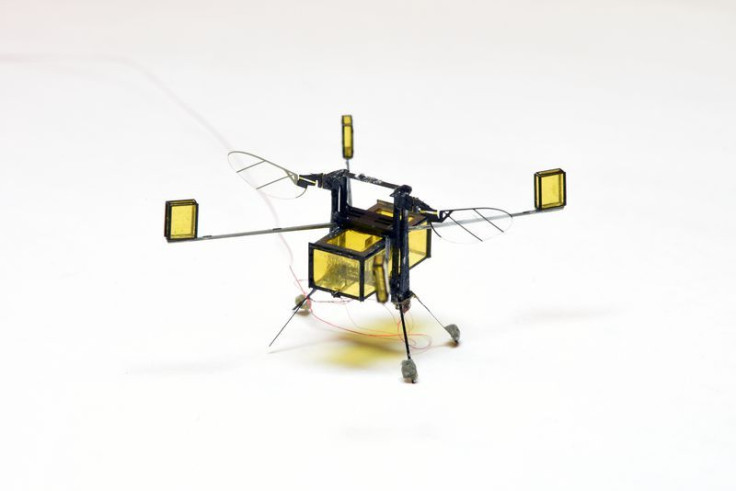WATCH: Harvard's Tiny RoboBee Propels Itself Out Of Water Using Rockets

The RoboBee project that Harvard first unveiled in 2013 has gone through a plethora of changes and upgrades. The latest one is its most advanced yet.
We have seen the RoboBee perform some crazy stunts. It can stick to surfaces and swim underwater. Now, researchers have upgraded the robotic bee to fly, dive into the water, and hop right back up into the air.
This is a notable step because the tiny machine is only two centimeters tall and is about one-fifteenth the weight of a penny.
The force exerted by the water on an object that small is tremendous. According to a report by The Verge, the RoboBee weighs just 175 milligrams and at this size, surface tension is like extra strong gravity — this is the 10 times the robot’s weight, and three times its lifting power.
“The force from surface tension feels like an impenetrable wall,” said Harvard professor of engineering Robert Wood in a press release on the website of Harvard University.
According to this release, "designing a millimeter-sized robot that moves in and out of water has numerous challenges. First, water is 1,000 times denser than air, so the wing flapping speed must vary widely between the two mediums. If the flapping frequency is too low, the RoboBee can’t fly. If it’s too high, the wing will snap off in water.”
“At the millimeter scale, the water’s surface might as well be a brick wall,” said the release. “Surface tension is more than 10 times the weight of the RoboBee and three times its maximum lift. Previous research demonstrated how impact and sharp edges can break surface tension on a RoboBee’s entry,” but the team had to figure out how to counter these forces and get the bot back out of the water.
To team countered this force exerted by the water by arming the RoboBee with a tiny combustible rocket. This rocket works by using the water as a fuel to propel the RoboBee’s out of the water. According to the report, the rocket works by filling a chamber in the interior of the bot with gas which is lit by an internal spark. The water is shot out of the bot which propels it out of the water.
The fuel is provided by the water. The gas in the chamber is obtained by converting water into oxyhydrogen, a violently explosive gas. This is done with the help of tiny electrolytic plate that breaks down individual water molecules into the gas. This process is very expensive and consumes a lot of power, but to propel a 175-milligram robot, it is very feasible.
“Because the RoboBee has a limited payload capacity, it cannot carry its own fuel, so we had to come up with a creative solution to exploit resources from the environment,” said Elizabeth Farrell Helbling, a graduate student in the Microrobotics Lab and co-author of the paper. “Surface tension is something that we have to overcome to get out of the water, but is also a tool that we can utilize during the gas collection process.”
The study was published in Science Robotics magazine. It was led by a team of scientists from the Harvard John A. Paulson School of Engineering and Applied Sciences (SEAS) and the Wyss Institute for Biologically-Inspired Engineering at Harvard.
© Copyright IBTimes 2025. All rights reserved.



















